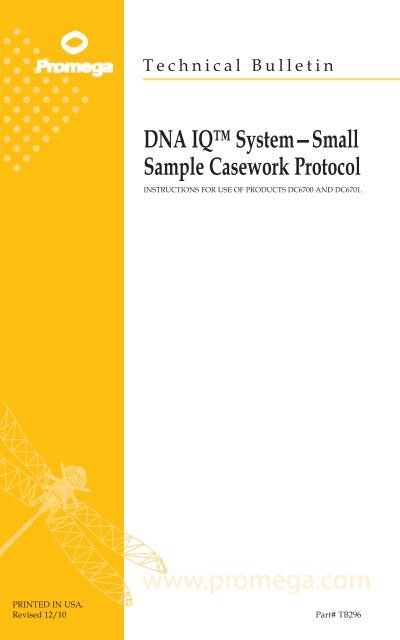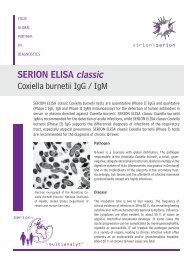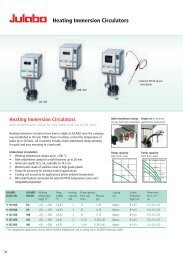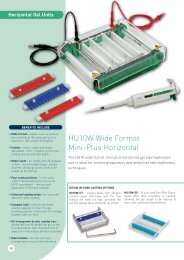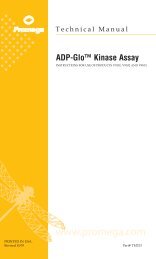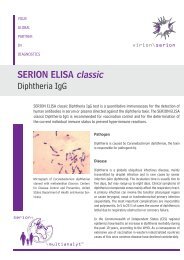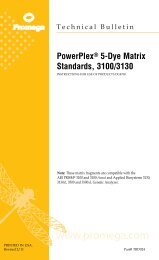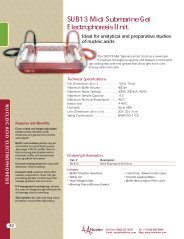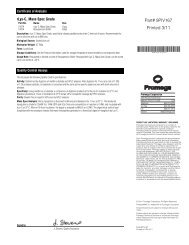DNA IQ System-Small Sample Casework Protocol Technical Bulletin ...
DNA IQ System-Small Sample Casework Protocol Technical Bulletin ...
DNA IQ System-Small Sample Casework Protocol Technical Bulletin ...
Create successful ePaper yourself
Turn your PDF publications into a flip-book with our unique Google optimized e-Paper software.
<strong>Technical</strong> <strong>Bulletin</strong><br />
<strong>DNA</strong> <strong>IQ</strong> <strong>System</strong>—<strong>Small</strong><br />
<strong>Sample</strong> <strong>Casework</strong> <strong>Protocol</strong><br />
INSTRUCTIONS FOR USE OF PRODUCTS DC6700 AND DC6701.<br />
PRINTED IN USA.<br />
Revised 12/10<br />
Part# TB296
<strong>DNA</strong> <strong>IQ</strong> <strong>System</strong>—<strong>Small</strong><br />
<strong>Sample</strong> <strong>Casework</strong> <strong>Protocol</strong><br />
All technical literature is available on the Internet at: www.promega.com/tbs<br />
Please visit the web site to verify that you are using the most current version of this<br />
<strong>Technical</strong> <strong>Bulletin</strong>. Please contact Promega <strong>Technical</strong> Services if you have questions on use<br />
of this system. E-mail: genetic@promega.com.<br />
1. Description..........................................................................................................1<br />
2. Product Components and Storage Conditions ............................................2<br />
3. <strong>Sample</strong> Types Examined ..................................................................................5<br />
4. <strong>Protocol</strong> for the <strong>DNA</strong> <strong>IQ</strong> <strong>System</strong>................................................................6<br />
A. Preparation of Reagents ......................................................................................7<br />
B. <strong>DNA</strong> Isolation from Stains on Solid Material..................................................8<br />
C. <strong>DNA</strong> Isolation from Liquid <strong>Sample</strong>s ..............................................................10<br />
D. Processing of Sperm-Containing <strong>Sample</strong>s......................................................11<br />
5. Troubleshooting...............................................................................................12<br />
6. References .........................................................................................................13<br />
7. Composition of Buffers and Solutions .......................................................13<br />
8. Related Products ..............................................................................................14<br />
1. Description<br />
<strong>DNA</strong> analysis is playing an increasingly larger role in identifying both humans<br />
and animals. With the advent of large multiplexes such as the PowerPlex ® 16<br />
<strong>System</strong>, the amplification and analysis steps have been streamlined. However,<br />
the purification of <strong>DNA</strong> from a variety of samples is still a rate-limiting step in<br />
obtaining useful genotypes.<br />
Several procedures are currently used to purify <strong>DNA</strong> from samples adsorbed to<br />
surfaces. Biological material must first be removed from these surfaces. This is<br />
typically done by soaking the material, which may result in inefficient recovery<br />
of small samples. The <strong>DNA</strong> must then be purified from inhibitors of PCR<br />
amplification and other components that may interfere with accurate<br />
quantitation methods.<br />
Purification methods commonly used, such as phenol:chloroform extraction,<br />
use hazardous organic chemicals, require multiple centrifugations, may result in<br />
significant loss of material and can introduce amplification inhibitors. Chelex ®<br />
extraction is rapid but frequently leaves amplification inhibitors. Purification<br />
Promega Corporation · 2800 Woods Hollow Road · Madison, WI 53711-5399 USA<br />
Toll Free in USA 800-356-9526 · Phone 608-274-4330 · Fax 608-277-2516 · www.promega.com<br />
Printed in USA.<br />
Part# TB296<br />
Revised 12/10 Page 1
with silica matrices uses the affinity of <strong>DNA</strong> for silica and does not require<br />
organic components. Silica filters are convenient when used with a filtration<br />
system but tend to give lower yields and require extensive washing to remove<br />
the guanidine-based lysis buffer. Currently available silica magnetic particles<br />
tend to give higher yield but also need extensive washing.<br />
The <strong>DNA</strong> <strong>IQ</strong> <strong>System</strong> (a) uses a novel paramagnetic resin for <strong>DNA</strong> isolation.<br />
Using the <strong>DNA</strong> <strong>IQ</strong> <strong>System</strong> to process small casework samples requires two<br />
steps. For biological material on solid supports, the first step provides an easy,<br />
rapid, efficient and almost universal stain extraction method. This step is<br />
unnecessary for liquid samples. The second step uses the paramagnetic resin to<br />
purify <strong>DNA</strong> without requiring extensive washing to remove the lysis reagent.<br />
This system is designed to rapidly purify small quantities of <strong>DNA</strong> and give<br />
consistent yields for a specific sample type.<br />
The <strong>DNA</strong> <strong>IQ</strong> <strong>System</strong> has been automated using the Beckman Coulter Biomek ®<br />
2000 and 3000 Laboratory Automation Workstations and Tecan Freedom EVO ®<br />
100 liquid handler. For more information, see the <strong>DNA</strong> <strong>IQ</strong> <strong>System</strong> product<br />
profile at: www.promega.com/applications/hmnid/productprofiles/automation/.<br />
For more information about implementing these methods, contact Promega<br />
<strong>Technical</strong> Services (genetic@promega.com).<br />
2. Product Components and Storage Conditions<br />
Product Size Cat.#<br />
<strong>DNA</strong> <strong>IQ</strong> <strong>System</strong> 400 samples DC6700<br />
This system includes:<br />
• 3ml Resin<br />
• 150ml Lysis Buffer<br />
• 70ml 2X Wash Buffer<br />
• 50ml Elution Buffer<br />
Product Size Cat.#<br />
<strong>DNA</strong> <strong>IQ</strong> <strong>System</strong> 100 samples DC6701<br />
This system includes:<br />
• 0.9ml Resin<br />
• 40ml Lysis Buffer<br />
• 30ml 2X Wash Buffer<br />
• 15ml Elution Buffer<br />
Storage Conditions: Store all <strong>DNA</strong> <strong>IQ</strong> <strong>System</strong> reagents at 22–25°C.<br />
Promega Corporation · 2800 Woods Hollow Road · Madison, WI 53711-5399 USA<br />
Toll Free in USA 800-356-9526 · Phone 608-274-4330 · Fax 608-277-2516 · www.promega.com<br />
Part# TB296<br />
Printed in USA.<br />
Page 2 Revised 12/10
Cut or punch out sample, and<br />
place in a microcentrifuge tube.<br />
70°C<br />
Add prepared Lysis Buffer, and<br />
incubate at 70˚C for 30 minutes.<br />
Transfer Lysis Buffer and sample<br />
into <strong>DNA</strong> <strong>IQ</strong> Spin Basket.<br />
Centrifuge.<br />
Remove spin basket, and add<br />
resuspended resin. Vortex, and<br />
incubate at room temperature.<br />
Vortex, and place in magnetic<br />
stand. Carefully discard solution<br />
without disturbing resin.<br />
Wash with prepared Lysis Buffer.<br />
Wash three times with 1X Wash<br />
Buffer.<br />
Air-dry at room temperature.<br />
65°C<br />
Add Elution Buffer, and incubate<br />
at 65°C for 5 minutes.<br />
Remove tubes from heat, vortex<br />
and place on magnetic stand.<br />
Remove <strong>DNA</strong> solution.<br />
3237MB<br />
Figure 1. Schematic of <strong>DNA</strong> isolation from stains on solid material using the<br />
<strong>DNA</strong> <strong>IQ</strong> <strong>System</strong>. See Section 4.B for a detailed protocol.<br />
Promega Corporation · 2800 Woods Hollow Road · Madison, WI 53711-5399 USA<br />
Toll Free in USA 800-356-9526 · Phone 608-274-4330 · Fax 608-277-2516 · www.promega.com<br />
Printed in USA.<br />
Part# TB296<br />
Revised 12/10 Page 3
Mix liquid sample, prepared<br />
Lysis Buffer and resin. Vortex,<br />
and incubate at room temperature<br />
for 5 minutes.<br />
Vortex, and place in magnetic<br />
stand. Carefully discard solution<br />
without disturbing resin.<br />
Wash with prepared Lysis Buffer.<br />
Wash three times with 1X Wash<br />
Buffer.<br />
Air-dry at room temperature.<br />
65°C<br />
Add Elution Buffer, and incubate<br />
at 65°C for 5 minutes.<br />
Remove tubes from heat, vortex<br />
and place in magnetic stand.<br />
Remove <strong>DNA</strong> solution.<br />
3238MB<br />
Figure 2. Schematic of <strong>DNA</strong> purification from liquid samples using the <strong>DNA</strong> <strong>IQ</strong><br />
<strong>System</strong>. See Section 4.C for a detailed protocol.<br />
Promega Corporation · 2800 Woods Hollow Road · Madison, WI 53711-5399 USA<br />
Toll Free in USA 800-356-9526 · Phone 608-274-4330 · Fax 608-277-2516 · www.promega.com<br />
Part# TB296<br />
Printed in USA.<br />
Page 4 Revised 12/10
3. <strong>Sample</strong> Types Examined<br />
<strong>DNA</strong> from the following sample types have been successfully purified at<br />
Promega or by external forensic laboratories. Due to the nature of casework<br />
samples (i.e, the samples may have been exposed to environmental factors for<br />
long periods of time and the amount of biological material may be limiting),<br />
<strong>DNA</strong> yields may vary, and <strong>DNA</strong> may not be obtained from all samples. Please<br />
see the most updated list at: www.promega.com/dnaiqsamples/. Tissue<br />
masses, including hair, bone, and sperm, require a proteinase K digestion to<br />
obtain reliable amounts of <strong>DNA</strong>. Contact Promega <strong>Technical</strong> Services<br />
(genetic@promega.com) for the latest information on available protocols.<br />
Table 1. Types of <strong>Sample</strong>s From Which <strong>DNA</strong> Has Been Successfully Isolated<br />
Using the <strong>DNA</strong> <strong>IQ</strong> <strong>System</strong>.<br />
<strong>Sample</strong> Type Promega External Comments<br />
Fresh blood Yes Yes Works with the following anti-clotting<br />
reagents: EDTA, citrate, heparin, ACD.<br />
Frozen blood Yes Yes Old blood may produce lower yields.<br />
Bloodstains<br />
S&S 903 paper Yes Yes<br />
FTA ® paper Yes Yes<br />
Cotton Yes Yes<br />
Blue denim Yes Yes<br />
Black denim Yes Yes<br />
Soil<br />
Yes<br />
Leather Yes Yes<br />
Surface to swab<br />
Yes<br />
Buccal swabs<br />
Cotton Yes Yes<br />
Rayon<br />
Yes<br />
CEP paper<br />
Yes<br />
Swab to FTA ® paper<br />
Yes<br />
Foam swab to paper<br />
Yes<br />
Cigarette butt Yes Yes Use paper wrapping; filter may form<br />
gel if heated with prepared Lysis<br />
Buffer.<br />
Toothbrush Yes Soak bristles in prepared Lysis Buffer<br />
at 60°C for 30 minutes.<br />
Envelope Yes Soak in 0.5% SDS before adding<br />
2 volumes of prepared Lysis Buffer.<br />
Urine Yes <strong>Sample</strong> from bladder cancer patient.<br />
Promega Corporation · 2800 Woods Hollow Road · Madison, WI 53711-5399 USA<br />
Toll Free in USA 800-356-9526 · Phone 608-274-4330 · Fax 608-277-2516 · www.promega.com<br />
Printed in USA.<br />
Part# TB296<br />
Revised 12/10 Page 5
Table 2. <strong>Sample</strong>s Requiring a Proteinase K Digestion Prior to Addition of Twice<br />
the Recommended Volume of Lysis Buffer.<br />
<strong>Sample</strong> Type Promega External Comments<br />
Tissue<br />
Fresh Yes Yes See the Tissue and Hair Extraction Kit<br />
(for use with <strong>DNA</strong> <strong>IQ</strong>) <strong>Technical</strong><br />
<strong>Bulletin</strong> TB307.<br />
Formalin-fixed Yes Yes See the Tissue and Hair Extraction Kit<br />
(for use with <strong>DNA</strong> <strong>IQ</strong>) <strong>Technical</strong><br />
<strong>Bulletin</strong> TB307.<br />
Hair Yes Yes See the Tissue and Hair Extraction Kit<br />
(for use with <strong>DNA</strong> <strong>IQ</strong>) <strong>Technical</strong><br />
<strong>Bulletin</strong> TB307.<br />
Bone* Yes From pulverized bone samples.<br />
Antler* Yes From drill shavings.<br />
Differential extractions Yes See Section 4.D.<br />
*Requires the Bone Incubation Buffer containing 1mg/ml proteinase K for <strong>DNA</strong><br />
purification. Please contact <strong>Technical</strong> Services (genetic@promega.com) for a protocol for<br />
<strong>DNA</strong> isolation from bone samples.<br />
4. <strong>Protocol</strong> for the <strong>DNA</strong> <strong>IQ</strong> <strong>System</strong><br />
Materials to Be Supplied by the User<br />
• 95–100% ethanol<br />
• isopropyl alcohol<br />
• 1M DTT<br />
• 65°C heat block, water bath or thermal cycler<br />
• 70°C heat block, water bath or thermal cycler (for stain or swab extraction)<br />
• vortex mixer<br />
• Microtubes, 1.5ml (Cat # V1231)<br />
• <strong>DNA</strong> <strong>IQ</strong> Spin Baskets (Cat.# V1221)<br />
• aerosol-resistant pipette tips<br />
• MagneSphere ® Technology Magnetic Separation Stand (twelve-position)<br />
(Cat.# Z5342)<br />
• proteinase K, to process samples listed in Table 2.<br />
!<br />
Use of gloves and aerosol-resistant pipette tips is highly recommended to<br />
prevent cross-contamination.<br />
Promega Corporation · 2800 Woods Hollow Road · Madison, WI 53711-5399 USA<br />
Toll Free in USA 800-356-9526 · Phone 608-274-4330 · Fax 608-277-2516 · www.promega.com<br />
Part# TB296<br />
Printed in USA.<br />
Page 6 Revised 12/10
4.A. Preparation of Reagents<br />
Preparation of 1X Wash Buffer<br />
1. For DC6701 (100 samples) add 15ml of 95–100% ethanol and 15ml of<br />
isopropyl alcohol to the 2X Wash Buffer.<br />
For DC6700 (400 samples) add 35ml of 95–100% ethanol and 35ml of<br />
isopropyl alcohol to the 2X Wash Buffer.<br />
2. Replace cap, and mix by inverting several times.<br />
3. Mark label to record the addition of alcohols. Label bottle as 1X Wash<br />
Buffer. Solution can be stored at room temperature. Be sure bottle is closed<br />
tightly to prevent evaporation.<br />
Preparation of Lysis Buffer<br />
1. Determine the total volume of prepared Lysis Buffer to be used (Table 3),<br />
and add 1µl of 1M DTT for every 100µl of Lysis Buffer.<br />
Note: Increasing the DTT concentration in the prepared Lysis Buffer to<br />
60mM can improve the recovery of <strong>DNA</strong> from the sperm fraction of spermcontaining<br />
samples (Section 4.D). To prepare Lysis Buffer with a final<br />
concentration of 60mM DTT, add 6µl of 1M DTT to 100µl of Lysis Buffer.<br />
Table 3. Volume of Prepared Lysis Buffer Required Per <strong>Sample</strong>.<br />
<strong>Sample</strong> Lysis Buffer 1 Lysis Buffer 2 Total Volume<br />
Liquid samples (up to 40µl) 100µl 100µl 200µl<br />
1 Cotton swab 250µl 100µl 350µl<br />
1/4th CEP swab 250µl 100µl 350µl<br />
1–2 4mm punches<br />
of S&S 903 paper 150µl 100µl 250µl<br />
1–3 2mm punches<br />
of FTA ® paper 150µl 100µl 250µl<br />
Cloth up to 25mm 2 150µl 100µl 250µl<br />
1 For use in Section 4.B, Step 2, or Section 4.C, Step 1.<br />
2For use in Section 4.B, Step 9, or Section 4.C, Step 7.<br />
2. Mix by inverting several times.<br />
3. Mark and date label to record the addition of DTT. This solution can be<br />
stored at room temperature for up to a month if sealed.<br />
Note: If prepared Lysis Buffer forms a precipitate, warm solution to<br />
37–60°C.<br />
Promega Corporation · 2800 Woods Hollow Road · Madison, WI 53711-5399 USA<br />
Toll Free in USA 800-356-9526 · Phone 608-274-4330 · Fax 608-277-2516 · www.promega.com<br />
Printed in USA.<br />
Part# TB296<br />
Revised 12/10 Page 7
4.B. <strong>DNA</strong> Isolation from Stains on Solid Material<br />
The maximum <strong>DNA</strong> yield will depend on the sample type, even samples that<br />
contain <strong>DNA</strong> amounts in excess of the <strong>DNA</strong>-binding capacity of the resin. As<br />
expected for samples that do not contain <strong>DNA</strong> amounts exceeding the <strong>DNA</strong>binding<br />
capacity, the yield will vary with the sample type and amount.<br />
<strong>Sample</strong>s containing small amounts of <strong>DNA</strong> will have high effiencies of<br />
recovery; as the <strong>DNA</strong> content approaches the maximum <strong>DNA</strong> -binding<br />
capacity, efficiency decreases (see Figure 1 of the <strong>DNA</strong> <strong>IQ</strong> <strong>System</strong>—Database<br />
<strong>Protocol</strong>, #TB297).<br />
1. Place sample in a 1.5ml microcentrifuge tube (e.g. Microtubes, 1.5ml, Cat.#<br />
V1231).<br />
2. Add the appropriate volume of prepared Lysis Buffer. Different samples<br />
require different volumes of prepared Lysis Buffer; see Column 2 of Table 3<br />
for the appropriate volume to add at this point. Additional prepared Lysis<br />
Buffer may be used to cover entire sample. Close the lid, and incubate tube<br />
at 70°C for 30 minutes.<br />
Exceptions:<br />
• Heat-sensitive fabrics (e.g., polyester and nylon): Extract without heating.<br />
• Leather: Lysis Buffer extraction with or without heat may not work on<br />
some leathers. Extract in a small volume of aqueous buffer (100–200µl),<br />
then add 2 volumes of Lysis Buffer after removing matrix.<br />
Note: For small stains, an alternative approach is to place the stained<br />
material in a <strong>DNA</strong> <strong>IQ</strong> Spin Basket (Cat.# V1221) seated in a 1.5ml<br />
Microtube (Cat.# V1231). Add 100–150µl of prepared Lysis Buffer to the<br />
basket. Carefully close the lid, and incubate at 70°C for 30 minutes. Most of<br />
the buffer should remain in the basket if the indicated tubes and spin<br />
baskets are used. Proceed to Step 4.<br />
3. Remove the tube from the heat source, and transfer the prepared Lysis<br />
Buffer and sample to a <strong>DNA</strong> <strong>IQ</strong> Spin Basket seated in a 1.5ml Microtube.<br />
4. Centrifuge at room temperature for 2 minutes at maximum speed in a<br />
microcentrifuge. Remove the spin basket.<br />
Note: It is important to centrifuge the prepared Lysis Buffer and stained<br />
matrix to obtain maximum recovery.<br />
5. Vortex the stock resin bottle for 10 seconds at high speed or until resin is<br />
thoroughly mixed. Add 7µl of <strong>DNA</strong> <strong>IQ</strong> Resin to the sample. Keep the<br />
resin resuspended while dispensing to obtain uniform results.<br />
6. Vortex sample/Lysis Buffer/resin mixture for 3 seconds at high speed.<br />
Incubate at room temperature for 5 minutes. Vortex mixture for 3 seconds<br />
once every minute during this 5-minute incubation.<br />
Promega Corporation · 2800 Woods Hollow Road · Madison, WI 53711-5399 USA<br />
Toll Free in USA 800-356-9526 · Phone 608-274-4330 · Fax 608-277-2516 · www.promega.com<br />
Part# TB296<br />
Printed in USA.<br />
Page 8 Revised 12/10
7. Vortex tube for 2 seconds at high speed. Place tube in the magnetic stand.<br />
Separation will occur instantly.<br />
Note: If resin does not form a distinct pellet on the side of the tube, vortex<br />
the tube and quickly place back in the stand.<br />
!<br />
8. Carefully remove and discard all of the solution without disturbing the<br />
resin pellet on the side of the tube.<br />
Note: If some resin is drawn up in tip, gently expel resin back into tube to<br />
allow re-separation.<br />
!<br />
9. Add 100µl of prepared Lysis Buffer. Remove the tube from the magnetic<br />
stand, and vortex for 2 seconds at high speed.<br />
10. Return tube to the magnetic stand, and discard all Lysis Buffer.<br />
11. Add 100µl of prepared 1X Wash Buffer. Remove tube from the magnetic<br />
stand, and vortex for 2 seconds at high speed.<br />
12. Return tube to the magnetic stand, and discard all Wash Buffer.<br />
13. Repeat Steps 11 and 12 two more times for a total of three washes. Be sure<br />
that all of the solution has been removed after the last wash.<br />
14. With the tube in the magnetic stand and the lid open, air-dry the resin for<br />
5 minutes.<br />
Do not dry for more than 20 minutes, as this may inhibit removal of <strong>DNA</strong>.<br />
15. Add 25–100µl of Elution Buffer, depending on how much biological material<br />
was used. A lower elution volume ensures a higher final concentration of<br />
<strong>DNA</strong>.<br />
16. Close the lid, and vortex the tube for 2 seconds at high speed. Incubate the<br />
tube at 65°C for 5 minutes.<br />
17. Remove the tube from the heat source, and vortex for 2 seconds at high<br />
speed. Immediately place the tube on the magnetic stand.<br />
Tubes must remain hot until placed in the magnetic stand or yield will<br />
decrease.<br />
18. Carefully transfer the <strong>DNA</strong>-containing solution to a container of choice.<br />
Note: <strong>DNA</strong> can be stored at 4°C for short-term storage or at –20 or –70°C<br />
for long-term storage.<br />
Promega Corporation · 2800 Woods Hollow Road · Madison, WI 53711-5399 USA<br />
Toll Free in USA 800-356-9526 · Phone 608-274-4330 · Fax 608-277-2516 · www.promega.com<br />
Printed in USA.<br />
Part# TB296<br />
Revised 12/10 Page 9
4.C. <strong>DNA</strong> Isolation from Liquid <strong>Sample</strong>s<br />
This protocol is recommended for liquid samples, excluding liquid blood. A<br />
protocol for <strong>DNA</strong> purification from liquid blood can be found in the <strong>DNA</strong> <strong>IQ</strong><br />
<strong>System</strong>—Database <strong>Protocol</strong> #TB297.<br />
1. Prepare a stock solution of resin and Lysis Buffer by using the ratio of 7µl<br />
of resin to 93µl of prepared Lysis Buffer per sample (prepare extra to allow<br />
for losses during pipetting). The following equation will help determine the<br />
exact volumes to be made. Vortex the resin container for 10 seconds at high<br />
speed or until resin is thoroughly mixed.<br />
(Number of samples + 1) × 7µl = µl of resin<br />
(Number of samples + 1) × 93µl = µl of prepared Lysis Buffer<br />
2. Mix liquid sample gently, and place an aliquot of up to 40µl into a 1.5ml<br />
microcentrifuge tube.<br />
3. Vortex the resin/Lysis Buffer mixture for 3 seconds at high speed to ensure<br />
suspension of resin, and add 100µl of the mixture to the tube containing the<br />
liquid sample. The resin/Lysis Buffer mixture should be mixed again if the<br />
resin begins to settle while dispensing aliquots.<br />
4. Vortex the sample/Lysis Buffer/resin mix for 3 seconds at high speed.<br />
Incubate 5 minutes at room temperature. Vortex mixture for 3 seconds once<br />
every minute during this 5-minute incubation.<br />
5. Vortex for 2 seconds at high speed. Place tube in the magnetic stand.<br />
Separation will occur instantly.<br />
Note: If resin does not form a distinct pellet on the side of the tube, vortex<br />
the tube and quickly place it back in the stand.<br />
6. Carefully remove and discard all of the solution without disturbing the<br />
resin pellet on the side of the tube.<br />
7. Add 100µl of prepared Lysis Buffer. Remove tube from the magnetic stand,<br />
and vortex for 2 seconds at high speed.<br />
8. Return tube to the magnetic stand, and remove and discard all Lysis Buffer.<br />
9. Add 100µl of prepared 1X Wash Buffer. Remove tube from the magnetic<br />
stand, and vortex for 2 seconds at high speed.<br />
10. Return tube to the magnetic stand. Dispose of all Wash Buffer.<br />
11. Repeat Steps 9 and 10 two more times for a total of three washes. Be sure<br />
all of the solution has been removed after the last wash.<br />
12. With the tube in the magnetic stand and the lid open, air-dry the resin for<br />
5 minutes.<br />
Do not dry for more than 20 minutes, as this may inhibit removal of <strong>DNA</strong>.<br />
!<br />
Promega Corporation · 2800 Woods Hollow Road · Madison, WI 53711-5399 USA<br />
Toll Free in USA 800-356-9526 · Phone 608-274-4330 · Fax 608-277-2516 · www.promega.com<br />
Part# TB296<br />
Printed in USA.<br />
Page 10 Revised 12/10
13. Add 25–100µl of Elution Buffer, depending on how much biological material<br />
was used. A lower elution volume ensures a higher final concentration of<br />
<strong>DNA</strong>.<br />
14. Close the lid, and vortex tube for 2 seconds at high speed. Incubate at 65°C<br />
for 5 minutes.<br />
15. Remove the tube from the heat source, and vortex for 2 seconds at high<br />
speed. Immediately place on the magnetic stand.<br />
Tubes must remain hot until placed in the magnetic stand, or yield will<br />
decrease.<br />
!<br />
16. Carefully transfer the <strong>DNA</strong>-containing solution to a container of choice.<br />
Note: <strong>DNA</strong> can be stored at 4°C for short-term storage or at –20 or –70°C<br />
for long-term storage.<br />
4.D. Processing of Sperm-Containing <strong>Sample</strong>s<br />
The following approach describes <strong>DNA</strong> purification from differentially extracted<br />
samples of sperm and nonsperm fractions using the <strong>DNA</strong> <strong>IQ</strong> <strong>System</strong>. This<br />
approach has been successfully performed in a forensic laboratory setting (1).<br />
The sample of interest is first processed using the laboratory's validated<br />
differential extraction protocol (2), including the extraction of biological<br />
material from the solid support, proteinase K digestion in the absence of DTT<br />
and pelleting and washing of the sperm cells. The following steps are to be<br />
followed once the sperm and nonsperm fractions have been separated.<br />
There is no need to digest the sperm pellet with proteinase K and DTT, as the<br />
prepared Lysis Buffer in Step 1 will effectively disrupt the sperm cells after the<br />
initial proteinase K digestion.<br />
Increasing the DTT concentration in the prepared Lysis Buffer to 60mM can<br />
improve the recovery of <strong>DNA</strong> from the sperm fraction. To prepare Lysis<br />
Buffer with a final concentration of 60mM DTT, add 6µl of 1M DTT to 100µl of<br />
<strong>DNA</strong> <strong>IQ</strong> Lysis Buffer instead of 1µl of 1M DTT as described in Section 4.A.<br />
1. Add at least 2 volumes (minimum 100µl) of prepared Lysis Buffer and 7µl<br />
of resin to the sperm pellet.<br />
2. Vortex for 3 seconds at high speed, and incubate at room temperature for<br />
5 minutes.<br />
3. Proceed to Steps 5–16 of Section 4.C to purify <strong>DNA</strong> from this sperm<br />
fraction.<br />
4. Add two volumes of prepared Lysis Buffer and 7µl of resin to the<br />
nonsperm fraction.<br />
Note: If desired, 100µl of a 500µl extraction can be processed. This amount<br />
typically gives sufficient <strong>DNA</strong> for analysis.<br />
Promega Corporation · 2800 Woods Hollow Road · Madison, WI 53711-5399 USA<br />
Toll Free in USA 800-356-9526 · Phone 608-274-4330 · Fax 608-277-2516 · www.promega.com<br />
Printed in USA.<br />
Part# TB296<br />
Revised 12/10 Page 11
5. Vortex for 3 seconds at high speed, and incubate at room temperature for<br />
5 minutes.<br />
6. Proceed to Steps 5–16 of Section 4.C to purify <strong>DNA</strong> from this nonsperm<br />
fraction.<br />
5. Troubleshooting<br />
For questions not addressed here, please contact your local Promega Branch Office or<br />
distributor. Contact information available at: www.promega.com. E-mail: genetic@promega.com<br />
Symptoms<br />
Poor yield<br />
Poor resin “pellet” formed<br />
Coloration in final wash or eluted<br />
solution (may affect results of<br />
downstream assays)<br />
Causes and Comments<br />
Too much sample was used. Excessive amounts of<br />
sample can reduce the efficiency of <strong>DNA</strong> binding<br />
to the resin. Use less sample or more resin.<br />
Poor extraction. After heating stain in prepared<br />
Lysis Buffer, centrifuge buffer with matrix. Be sure<br />
enough liquid is present to wash out the <strong>DNA</strong>.<br />
Excessive drying of resin. Do not dry samples for<br />
more than 20 minutes, as overdrying the resin<br />
inhibits <strong>DNA</strong> elution.<br />
For sperm-containing samples, increasing the<br />
DTT concentration in the prepared Lysis Buffer<br />
to 60mM may improve yield (see Section 4.D).<br />
The resin settled before the tube was placed in<br />
the magnetic stand. <strong>Sample</strong>s should be placed in<br />
the magnetic stand immediately after mixing.<br />
Repeat mixing, and place tube in stand.<br />
Excessive input material was used relative to the<br />
recommended volumes of reagents. Use less<br />
initial sample. Consult protocols for recommended<br />
quantities of initial sample. Alternatively, use<br />
more resin per isolation. A proportional increase<br />
in resin will allow <strong>DNA</strong> capture from more<br />
initial sample. The increase in yield will be<br />
roughly proportional to the increase in resin.<br />
Insufficient washing. Remove all fluid during<br />
washes. Be sure that resin is completely<br />
resuspended during each wash step.<br />
Be sure a distinct resin pellet is formed during all<br />
washes.<br />
Use less initial sample.<br />
Perform additional washes with 1X Wash Buffer.<br />
Promega Corporation · 2800 Woods Hollow Road · Madison, WI 53711-5399 USA<br />
Toll Free in USA 800-356-9526 · Phone 608-274-4330 · Fax 608-277-2516 · www.promega.com<br />
Part# TB296<br />
Printed in USA.<br />
Page 12 Revised 12/10
5. Troubleshooting (continued)<br />
Symptoms<br />
Resin present in final eluted<br />
solution (may affect results of<br />
downstream assays)<br />
Inconsistent yield (may affect<br />
results from downstream assays)<br />
Causes and Comments<br />
Resin is occasionally transferred by rapid pipetting<br />
or is caught in the meniscus of the final eluate.<br />
Vortex or mix solution, place in the magnetic<br />
stand and transfer eluate to new tube.<br />
Inconsistent amounts of resin. Vortex resin stock<br />
just before making aliquots. Be sure to vortex the<br />
resin/Lysis Buffer mixture while dispensing<br />
aliquots.<br />
Excessive drying of resin. Do not dry samples for<br />
more than 20 minutes, as overdrying the resin<br />
inhibits <strong>DNA</strong> elution.<br />
Contaminating nonhuman <strong>DNA</strong> in the initial<br />
sample can decrease yield of human <strong>DNA</strong>. The<br />
<strong>DNA</strong> <strong>IQ</strong> <strong>System</strong> captures total <strong>DNA</strong>,<br />
including single- and double-stranded <strong>DNA</strong>.<br />
6. References<br />
1. Greenspoon, S. and Ban, J. (2002) Robotic extraction of mock sexual assault samples<br />
using the Biomek ® 2000 and the <strong>DNA</strong> <strong>IQ</strong> <strong>System</strong>. Profiles in <strong>DNA</strong> 5, 3–5.<br />
2. Gill, P. et al. (1985) Forensic application of <strong>DNA</strong> 'fingerprints'. Nature 318, 577–9.<br />
7. Composition of Buffers and Solutions<br />
Elution Buffer<br />
10mM Tris (pH 8.0)<br />
0.1mM EDTA<br />
Bone Incubation Buffer<br />
10mM Tris (pH 8.0)<br />
100mM NaCl<br />
50mM EDTA<br />
0.5% SDS<br />
Promega Corporation · 2800 Woods Hollow Road · Madison, WI 53711-5399 USA<br />
Toll Free in USA 800-356-9526 · Phone 608-274-4330 · Fax 608-277-2516 · www.promega.com<br />
Printed in USA.<br />
Part# TB296<br />
Revised 12/10 Page 13
8. Related Products<br />
Product Size Cat.#<br />
MagneSphere ® Technology Magnetic<br />
Separation Stand (two-position) 1.5ml Z5332<br />
MagneSphere ® Technology Magnetic<br />
Separation Stand (twelve-position) 1.5ml Z5342<br />
PolyATtract ® <strong>System</strong> 1000 Magnetic<br />
Separation Stand 1 each Z5410<br />
<strong>DNA</strong> <strong>IQ</strong> Spin Baskets* 1,000/pk V1221<br />
Microtubes, 1.5ml 1,000/pk V1231<br />
ART ® 20P, Pipet Tip, 20µl 960/pk DY1071<br />
ART ® 200, Pipet Tip, 200µl 960/pk DY1121<br />
ART ® 1000E, Pipet Tip, 1,000µl 800/pk DY1131<br />
Slicprep 96 Device 10 pack V1391<br />
AluQuant ® Human <strong>DNA</strong> Quantitation <strong>System</strong>* 80 determinations DC1010<br />
400 determinations DC1011<br />
Tissue and Hair Extraction Kit (for use with <strong>DNA</strong> <strong>IQ</strong>) 100 reactions DC6740<br />
DTT, Molecular Grade (Dry Powder) 5g V3151<br />
25g V3155<br />
PowerPlex ® 16 <strong>System</strong>* 100 reactions DC6531<br />
400 reactions DC6530<br />
PowerPlex ® 1.1 and 2.1 <strong>System</strong>s* 100 reactions DC6501<br />
400 reactions DC6500<br />
PowerPlex ® 1.2 <strong>System</strong>* 100 reactions DC6101<br />
*Not For Medical Diagnostic Use.<br />
(a)U.S. Pat. Nos. 6,027,945, 6,368,800 and 6,673,631, Australian Pat. No. 732756, European Pat. Nos. 0 895 546 and<br />
1 204 741 and Mexican Pat. No. 209436 have been issued to Promega Corporation for methods of isolating biological target<br />
materials using silica magnetic particles and simultaneous isolation and quantitation of <strong>DNA</strong>. Other patents are pending.<br />
© 2010 Promega Corporation. All Rights Reserved.<br />
AluQuant, MagneSphere, PolyATtract and PowerPlex are registered trademarks of Promega Corporation. <strong>DNA</strong> <strong>IQ</strong> is a<br />
trademark of Promega Corporation.<br />
ART is a registered trademark of Molecular Bio-Products, Inc. Biomek is a registered trademark of Beckman Coulter, Inc.<br />
Chelex is a registered trademark of Bio-Rad Laboratories, Inc. Freedom EVO is a registered trademark of Tecan AG<br />
Corporation. FTA is a registered trademark of Flinders Technologies, Pty, Ltd., and is licensed to Whatman.<br />
Products may be covered by pending or issued patents or may have certain limitations. Please visit our Web site for more<br />
information.<br />
All prices and specifications are subject to change without prior notice.<br />
Product claims are subject to change. Please contact Promega <strong>Technical</strong> Services or access the Promega online catalog for the<br />
most up-to-date information on Promega products.<br />
Promega Corporation · 2800 Woods Hollow Road · Madison, WI 53711-5399 USA<br />
Toll Free in USA 800-356-9526 · Phone 608-274-4330 · Fax 608-277-2516 · www.promega.com<br />
Part# TB296<br />
Printed in USA.<br />
Page 14 Revised 4/06


